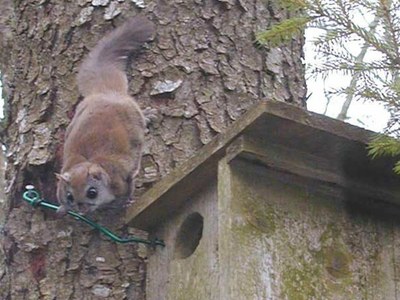Virginia Cooperative Research Unit
 The Virginia Cooperative Fish and Wildlife Research Unit is a vibrant and intergral part and partner with the Virginia Tech Department of Fisheries and Wildlife Conservation that supports graduate research and education. It consists of two federal scientists, an unit administrator, 12 graduate students and 1 post-doctoral researcher along with numerous "cooperating" faculty and graduate students whom work in association with the unit and its projects.
The Virginia Cooperative Fish and Wildlife Research Unit is a vibrant and intergral part and partner with the Virginia Tech Department of Fisheries and Wildlife Conservation that supports graduate research and education. It consists of two federal scientists, an unit administrator, 12 graduate students and 1 post-doctoral researcher along with numerous "cooperating" faculty and graduate students whom work in association with the unit and its projects.
Active Projects:
Cerulean Warbler Response to Variable Density Thinning and Other Silvicultural Prescriptions
We are proposing a region-wide study during 2013-2016 to address cerulean warbler and associated species response to a variety of planned harvests and management activities. The overarching management goal is to create CERW habitat via variable density thinning, shelterwood, and firewood harvests as well as non-commercial overstory herbicide treatments across the wide range of site conditions, age classes, and landscape configurations that are within the parameters of typical forest management at the state wildlife management area and state forest scale and purpose.
Micro-habitat Characteristics of Virginia Northern Flying Squirrel Foraging Sites
We propose to conduct an examination of Virginia northern flying squirrel foraging micro-habitat characteristics from previous summer/fall home range and habitat use data from the Monongahela National Forest and Kumbrabow State Forest and from squirrels that will be radio-collared and tracked in the late spring-summer-early fall 2012 and 2013 at Snowshoe Resort and the Upper Greenbrier project area of the Monongahela National Forest. We will establish vegetation and soil survey plots in association with telemetry points and random points. Primary emphasis will be to determine the extent of association of foraging points with red spruce over- and mid-story cover and the presence of folistic epipedons as well as to determine if these characteristics are quantifiable in a probabilistic, predictive manner that could be used to refine and modify the current Virginia northern flying squirrel predicted distribution maps.
Allegheny Woodrat: Identifying Strategies to Conserve a Declining Species
Hypotheses regarding the decline of this species focus on food resources (forest conditions), disease, and habitat isolation. We propose to use datasets from throughout the range of the species to test predictions from these hypotheses and to identify risk factors. This analysis using existing datasets will help quantify a structured decision analysis that can be used to guide habitat management or population restoration actions. The results of the decision model will provide the foundation for a multi-state adaptive management program to maximize the effectiveness of ongoing management activities.
Find more Active and Completed Projects here
Right






















